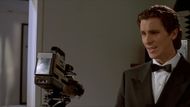On the surface, the 2000s cult horror comedy, American Psycho, may appear as a sleek crime thriller that recounts the story of a wealthy young urban professional living a double life. Under the carefully placed synth-heavy scores and glimmering display of fashion lies a psychological horror story built upon dark satire. American Psycho does not give you just any other serial killer. Instead, you get a full-scale critique of the yuppies from the time. Patrick Bateman is a serial killer who is obsessed with his appearance. Let us just say we saw one of those coming from the infamous serial killer clans to be quite obsessed with morning routines.
Those who have already watched this film by Mary Harron may already know that there are some scenes in American Psycho where we see the use of mirrors. While it is understandable you'd need a mirror for your morning routine glam up, you obviously need a mirror, but the movie does not stop at that.
While we all have our own theories, let us take a look at some that stand out.
Mirror scenes in American Psycho (contains spoilers and writer's opinions)

There are a lot of mirror scenes in American Psycho. Some scenes do not explicitly showcase mirrors, but they use glossy surfaces instead. You see different types of mirrors in different scenes. The most popular one is in Patrick's apartment itself, where he glamorizes up for a day of killing.
We also have the scene where, moments before, Patrick goes for the kill. In the frame, we have Paul Allen, oblivious to Patrick's intention. Patrick gives a brief talk, goes in front of the mirror in the changing room, and checks himself out with a cold stare.
Again, as more minutes into the movie pass, you have the infamous sex scene between Patrick and his two hired sex workers. Guess what? The entire time, Patrick stays weirdly fixated on their reflection during the sexual acts. His weird obsession with mirrors is not implicit. The director took enough care to make it as clear as crystal for you to notice.
The mirrors and glossy surfaces add to the overall glossy, well-kempt appearance that Patrick desperately tries to adorn. He is always properly dressed, mostly in lintless formals. So much so that his appearance begins to challenge your conventional ideas of who, at all, is a civilized person. Generally, one may think that a well-kempt, neatly dressed person would be pretty safe to be around. Well, wait until you see American Psycho!
The mirrors do exactly what they are meant to. Imagine what happens when you throw light at a mirror. It reflects it, consequently filling up your ambiance with more brightness. When Patrick looks in the mirror, we see his determination to pursue his targets and convert each target into a dead body. As horrifying as it may sound, in a horror-crime film, what else can you expect?
Let us now take a serial analysis of the theories we can apply to the scene
Why do we have so many mirror scenes in American Psycho? Explained
1. They reflect and highlight his narcissism

Patrick Bateman is not your typical Ed Kemper. He does not kill for rage or revenge—he kills because he wants to assert control. In a way, an extension of this thought perfectly explains why he is so obsessed with his skin and his superbly organized way of maintaining himself. From top to bottom, psychologically speaking, if anybody has a good look at Patrick, he will be compelled to think that he has it all under control—even those stubborn skin breakouts we all suffer from. In almost every major killing scene, there’s a mirror nearby. They accentuate the violent nature of the crime unfolding in front of us, mirroring back the perversion at us.
He enjoys the almost theatrical spectacle of committing violent crimes more than the act of killing itself. To sum up, he is a narcissist who strives to uphold his image as one who is always in control, and never does he like to be controlled.
2. To let the satire speak the loudest:
Patrick Bateman is a representative of a particular social class of people that Mary Harron wanted to critique through this horror satire: the 'young urban professionals' of the Wall Street era who were neat, walked with a briefcase, and had erect spines. Eyes full of dreams and a handful of coffee cups to keep them going through the hectic office day.
While that was a time of prosperity for many, some fell prey to a toxic obsession with the societal image of masculinity. Mirrors capture this very well. They own, by being a reflective surface, no real depth. Stretching this observation, then, it may have been a directorial intent to highlight the hollowness that lies underneath characters like Bateman.
3. They emphasize the horror element:
There is a reason why so many classic horror movies use mirrors in key scenes. Some of them use it to add an element of illusion into the scenes, while others use it to give you an impression that, as you watch the reflection, you become integral to the scene unfolding before you.
The mirrors in American Psycho capitalize the horror beneath all the semblance of neatness. Think of it this way: you can organize your table, you can organize your bed. But when you are not willing to look at something, the mirror will still reflect it. With or without your will, it will just do what it is meant to do, just like Bateman. To sum it up, a crime is anything but neat. The mirror reflections are also anything but neat, or something you can actively control if you are not really careful about it.
Maybe the directors wanted us to see this and observe the ultimate element of shock and horror.
Also read: 10 genre-bending cult comedies like Big Trouble in Little China
Love movies? Try our Box Office Game and Movie Grid Game to test your film knowledge and have some fun!
